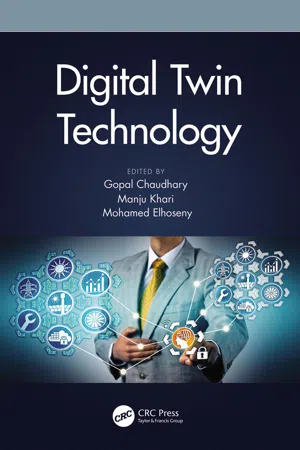
Digital Twin Technology
Gopal Chaudhary, Manju Khari, Mohamed Elhoseny, Gopal Chaudhary, Manju Khari, Mohamed Elhoseny
- 256 pagine
- English
- ePUB (disponibile sull'app)
- Disponibile su iOS e Android
Digital Twin Technology
Gopal Chaudhary, Manju Khari, Mohamed Elhoseny, Gopal Chaudhary, Manju Khari, Mohamed Elhoseny
Informazioni sul libro
Most of the business sectors consider the Digital Twin concept as the next big thing in the industry. A current state analysis of their digital counterparts helps in the prediction of the future of physical assets. Organizations obtain better insights on their product performance through the implementation of Digital Twins, and the applications of the technology are frequently in sectors such as manufacturing, automobile, retail, health care, smart cities, industrial IoT, etc. This book explores the latest developments and covers the significant challenges, issues, and advances in Digital Twin Technology. It will be an essential resource for anybody involved inrelated industries, as well as anybody interested in learning more about this nascent technology.
This book includes:
- The future, present, and past of Digital Twin Technology.
- Digital twin technologies across the Internet of Drones, which developed various perceptive and autonomous capabilities, towards different control strategies such as object detection, navigation, security, collision avoidance, and backup. These approaches help to deal with the expansive growth of big data solutions.
- The recent digital twin concept in agriculture, which offers the vertical framing by IoT installation development to enhance the problematic food supply situation. It also allows for significant energy savings practices. It is highly required to overcome those challenges in developing advanced imaging methods of disease detection & prediction to achieve more accuracy in large land areas of crops.
- The welfare of upcoming archetypes such as digitalization in forensic analysis. The ideas of digital twin have arisen to style the corporeal entity and associated facts reachable software and customers over digital platforms.
- Wind catchers as earth building: Digital Twins vs. green sustainable architecture.
Domande frequenti
Informazioni
1 Digital Twin Technology
An Evaluation
CONTENTS
- 1.1 Introduction: Background
- 1.2 Digital Twin Technology
- 1.3 Digital Twin Technology Using Convolutional Neural Networks with IoT
- 1.4 Digital Twin Technology Using Recurrent Neural Networks with IoT
- 1.5 Digital Twin Technology Using Long Short-Term Memory with IoT
- 1.6 Digital Twin Technology Using Autoencoders and Variational Autoencoders with IoT
- 1.7 Digital Twin Technology Using Generative Adversarial Networks with IoT
- 1.8 Digital Twin Technology Using Restricted Boltzmann Machine with IoT
- 1.9 Deep Learning on IoT Along with Other Algorithms
- 1.9.1 Digital Twin Technology with IoT Applications
- 1.9.2 Digital Twin Technology with Smart Homes
- 1.9.3 Digital Twin Technology with Smart City
- 1.9.4 Digital Twin Technology with Energy
- 1.9.5 Digital Twin Technology Using Intelligent Transportation System
- 1.9.6 Digital Twin Technology in Healthcare and Lifestyle
- 1.9.7 Digital Twin Technology in Agriculture
- 1.9.8 Digital Twin Technology in Education
- 1.9.9 Digital Twin Technology in Industry
- 1.9.10 Digital Twin Technology in Government
- 1.9.11 Digital Twin Technology in Sports
- 1.9.12 Digital Twin Technology in Retail
- 1.9.13 Digital Twin Technology in Smart IoT Infrastructure
- 1.9.14 Digital Twin Technology in On-Board ML on IoT Devices
- 1.9.15 Digital Twin Technology in Network Compression
- 1.9.16 Digital Twin Technology in Approximate Computing
- 1.9.17 Digital Twin Technology in Hardware Improvement
- 1.9.18 Digital Twin Technology with ML for IoT Infrastructure
- 1.9.19 Digital Twin Technology in IoT Infrastructure Security
- 1.10 Digital Twin Technology: Future of IoT
- References
1.1 INTRODUCTION: BACKGROUND

1.2 DIGITAL TWIN TECHNOLOGY
Indice dei contenuti
- Cover
- Half Title
- Title Page
- Copyright Page
- Table of Contents
- Editors
- Contributors
- Chapter 1 Digital Twin Technology: An Evaluation
- Chapter 2 Digital Twin: Towards Internet of Drones
- Chapter 3 Digital Twin in Agriculture Sector: Detection of Disease Using Deep Learning
- Chapter 4 Crop Diseases Detection and Prevention Using AI and Machine Learning Techniques
- Chapter 5 Architecture of Digital Twin for Network Forensic Analysis Using Nmap and Wireshark
- Chapter 6 Wind Catchers as Earth Building: Digital Twins vs Green Sustainable Architecture
- Chapter 7 Digital Twin and the Detection and Location of DoS Attacks to Secure Cyber-Physical UAS
- Chapter 8 Digital Twin Techniques in Recognition of Human Action Using the Fusion of Convolutional Neural Network
- Chapter 9 eVote – A Decentralized Voting Platform
- Chapter 10 Nessus: A Vulnerability Scanner Tool in Network Forensic
- Chapter 11 Case Studies Related to Depression Detection Using Deep Learning Techniques
- Index